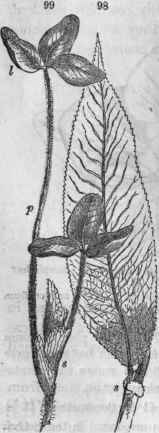Of The Petiole
Description
This section is from the book "Class-Book Of Botany USA&Canada", by Alphonso Wood. Also available from Amazon: Class-Book Of Botany.
Of The Petiole
243. The form of the distinct petiole is rarely cylindrical, but more generally flattened or channeled on the upper side. When it is flattened in a vertical direction, it is said to be compressed, as in the aspen or poplar. In this case the blade is very unstable, and agitated by the least breath of wind.
244. The winged petiole is flattened or expanded into a margin, but laterally instead of vertically, as in the asters. Sometimes the margins outrun the petioles, and extend down the stem, making that winged or alate also. Such leaves are said to be decurrent (decurro, run down). Ex. Mullein.

98. Leaf of willow (Salix lucida); 8, the stipules. The midvein is 3-lined; veinlets 2-lined; veinulets single-lined. 80, clover leaves; 8, stipules, p, petiole, l, leaflets.
245. The amplexicaul or stem-clasping petiole is dilated at the base into a margin which surrounds or clasps the stem, as in the umbilifers. Frequently we find the stem-clasping margins largely developed, constituting a sheath - with free edges in the grasses, or closed into a tube in the sedges.
246. The petiole is simple in the simple leaf, but compound or branched in the compound leaf, with as many branches (petiolules) as there are divisions of the lamina.
Continue to:


